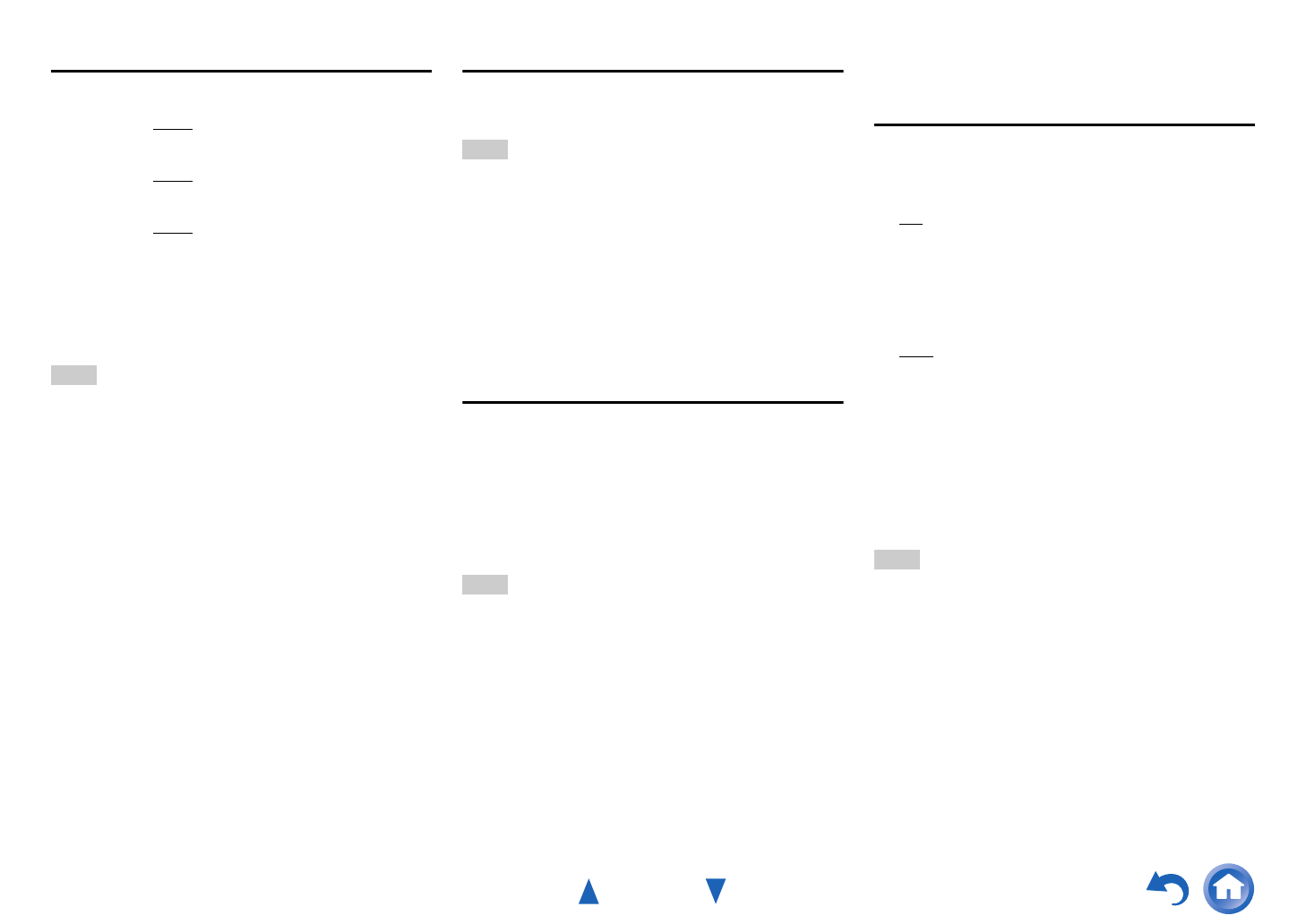
Advanced Operations
En-59
Speaker Levels
■ Subwoofer 1
`–15.0dB to 0.0dB
to +12.0dB in 0.5 dB steps.
■ Subwoofer 2
*1
`–15.0dB to 0.0dB to +12.0dB in 0.5 dB steps.
■ Center
`–12.0dB to 0.0dB to +12.0dB in 0.5 dB steps.
You can adjust the volume of each speaker while listening
to an input source.
These temporary adjustments are cancelled when the AV
receiver is set to standby. To save the setting you made
here, go to “Level Calibration” (➔ page 69) before
setting the AV receiver to standby.
Note
• You cannot use these function while the AV receiver is muted.
• These settings cannot be used while a pair of headphones is
connected.
• Speakers that are set to “No” or “None” in “Speaker
Configuration” (➔ page 67) cannot be adjusted.
•When “Sound Program” is enabled, “Subwoofer 1” and
“Subwoofer 2” cannot be used if the “Subwoofer” setting is set
to “No” in “Sound Program Edit” (➔ page 75).
*1
If the “Subwoofer” setting is set to “1ch”, this setting cannot
be selected (➔ page 67).
Dolby Volume
■ Dolby Volume
See “Dolby Volume” of “Audio Adjust” (➔ page 73).
Note
• This setting cannot be used in either of the following cases:
– The Pure Audio or Direct listening mode is selected.
– Speakers B is being used.
– Any of the THX listening modes is selected, with “Loudness
Plus” set to “On” or “Preserve THX Settings” set to “Yes”
(➔ page 70).
• When “Dolby Volume” is set to “On”, the “Dynamic EQ” and
“Dynamic Volume” settings of all input selectors are switched to
“Off”.
• When “Sound Program” is enabled, the setting must be made
with “Sound Program Edit” (➔ page 75).
Audyssey
®
■ Audyssey
See “Audyssey” in “Source Setup” (➔ page 76).
■ Dynamic EQ
See “Dynamic EQ” in “Source Setup” (➔ page 76).
■ Dynamic Volume
See “Dynamic Volume” in “Source Setup” (➔ page 76).
Note
• These technologies can be used when all the following conditions
are met:
– Room Correction and Speaker Setup is completed. Note that
“Audyssey” requires the “Audyssey MultEQ XT32 Full
Calibration” method.
– Any listening mode other than Direct or Pure Audio is selected.
– A pair of headphones is not connected.
– Speakers B is not being used.
• The setting is stored individually for each input selector.
•“Dynamic EQ” and “Dynamic Volume” cannot be selected
when any of the THX listening modes is selected, with
“Loudness Plus” set to “On” or “Preserve THX Settings” set to
“Yes” (➔ page 70).
• When “Sound Program” is enabled, the setting must be made
with “Sound Program Edit” (➔ page 75).
Late Night
■ Late Night
For Dolby Digital and Dolby Digital Plus sources, the
options are:
`Off
`Low:
Small reduction in dynamic range.
`High:
Large reduction in dynamic range.
For Dolby TrueHD sources, the options are:
`Auto
:
The Late Night function is set to “On” or “Off”
automatically.
`Off
`On
Turn this setting on to reduce the dynamic range of Dolby
Digital material so that you can still hear quiet parts even
when listening at low volume levels—ideal for watching
movies late at night when you don’t want to disturb
anyone.
Note
• The effect of the Late Night function depends on the material that
you are playing and the intention of the original sound designer,
and with some material there will be little or no effect when you
select the different options.
• The Late Night function can be used only when the input source
is Dolby Digital, Dolby Digital Plus, or Dolby TrueHD.
• The Late Night function is set to “Off” when the AV receiver is
set to standby. For Dolby TrueHD sources, it will be set to
“Auto”.
• With Dolby TrueHD sources, the Late Night function cannot be
used when “TrueHD Loudness Management” is set to “Off”
(➔ page 73).
• The Late Night function cannot be used when “Dolby Volume”
is set to “On”.


















